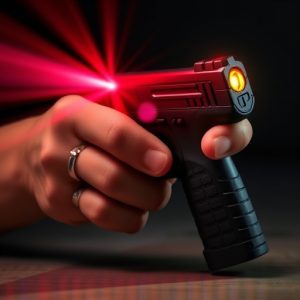Unveiling Stun Guns: Specs, Safety, and Effectiveness Explained
Stun guns, popular non-lethal self-protection devices, temporarily incapacitate aggressors through h…….
Stun guns, popular non-lethal self-protection devices, temporarily incapacitate aggressors through high-voltage, low-current electrical pulses. Modern models feature laser sights and adjustable intensity settings. Understanding their operation and safety implications—including legal considerations and potential side effects—is crucial for effective and responsible use in various situations.
“In today’s world, personal safety is paramount. This article explores non-lethal self-protection devices, with a focus on stun guns—their mechanics and effectiveness. We delve into the science behind these tools, uncovering how they disable aggressors without causing permanent harm. Key specifications for optimal defense are outlined, from voltage and weight to activation methods. Additionally, we address safety and legal aspects crucial for responsible ownership. Understanding how stun guns work is essential for anyone seeking effective yet non-lethal self-defense options.”
- Understanding Non-Lethal Self-Protection Devices
- The Science Behind Stun Guns: How They Work
- Key Specifications for Effective Self-Defense Tools
- Safety and Legal Considerations for Stun Gun Owners
Understanding Non-Lethal Self-Protection Devices
Non-lethal self-protection devices, such as stun guns, are designed to incapacitate an aggressor temporarily without causing permanent harm or death. These tools have gained popularity for personal safety and self-defense purposes. One of the most common types is the stun gun, which uses electrical current to disrupt muscle control in the target’s body, leading to temporary paralysis and a severe jolt.
Stun guns operate by delivering a high voltage, low-current electric discharge when activated. This shock can cause the victim to lose balance, fall, or become temporarily incapacitated, providing the user with an opportunity to escape or deter further aggression. The device typically features a trigger mechanism that, when squeezed, initiates the electrical discharge. Modern stun guns often include additional safety features like laser sights for accurate targeting and various settings to adjust the intensity of the shock, ensuring users have control over their level of protection.
The Science Behind Stun Guns: How They Work
Stun guns, also known as electroshock weapons, operate on the principle of delivering an electric shock to disable or subdue a target. They use a high-voltage, low-current electrical pulse that interrupts the target’s nerve signals and muscles, causing temporary paralysis and disorientation. This disruption is achieved through a specialized probe or darts that make contact with the subject, transmitting the electric charge. The current disrupts the body’s normal electrical signals, resulting in muscle spasms and loss of balance.
The device generates this pulse using two primary components: an electrochemical cell (battery) and an electronic control circuit. The battery provides the necessary voltage, while the control circuit regulates and triggers the discharge of electricity. Modern stun guns feature advanced circuitry that allows for adjustable shock levels, ensuring a tailored response to different situations and targets without causing permanent harm. This technology has evolved significantly since its inception, enhancing safety and effectiveness in non-lethal self-defense scenarios.
Key Specifications for Effective Self-Defense Tools
When it comes to non-lethal self-defense devices, understanding their key specifications is paramount for effectiveness and safety. One such device that has gained popularity is the stun gun, a tool designed to incapacitate an assailant temporarily. But how does a stun gun work? It utilizes high voltage, low current electrical pulses to disrupt muscle control in the target’s body, causing them to lose balance and strength. This technology ensures that the user can disable an attacker without causing permanent harm.
Effective self-defense tools should possess several critical attributes. Firstly, they must be compact and lightweight, allowing for easy carrying and quick access during emergencies. Secondly, a robust power source is essential; rechargeable batteries with long lifespans are preferable to reduce frequency of replacement. Additionally, an adjustable output level feature enables users to adapt the device’s intensity based on situations, ensuring optimal effectiveness without excessive force. Finally, reliable functionality in adverse conditions, such as water resistance or durability against impacts, enhances their practicality for self-defense scenarios.
Safety and Legal Considerations for Stun Gun Owners
When considering non-lethal self-protection devices like stun guns, it’s crucial to understand safety and legal implications. Stun guns use an electric current to temporarily incapacitate a target, with the primary mechanism being electrical discharge through metal probes or contacts upon contact or proximity. However, how does a stun gun work beyond its physical effects? It’s essential for owners to grasp that these devices are subject to stringent regulations varying across jurisdictions.
Legal considerations include understanding local laws regarding stun guns, permits required for ownership and carry, and restrictions on power output levels. Safety measures involve proper training in the device’s use, storage in a secure location out of reach of children or unauthorized individuals, and regular maintenance to ensure functionality. Owners should also be aware of potential side effects like muscle contractions, disorientation, or even respiratory distress in some cases, emphasizing the need for responsible usage and understanding of the device’s capabilities.
Non-lethal self-protection devices, particularly stun guns, offer a powerful tool for personal safety without causing permanent harm. Understanding their science and key specifications is crucial for effective self-defense. As you navigate the world of non-lethal weapons, remember to prioritize safety and legal considerations to ensure responsible ownership. Knowing how a stun gun works can empower individuals to protect themselves and make informed decisions in potentially dangerous situations.


